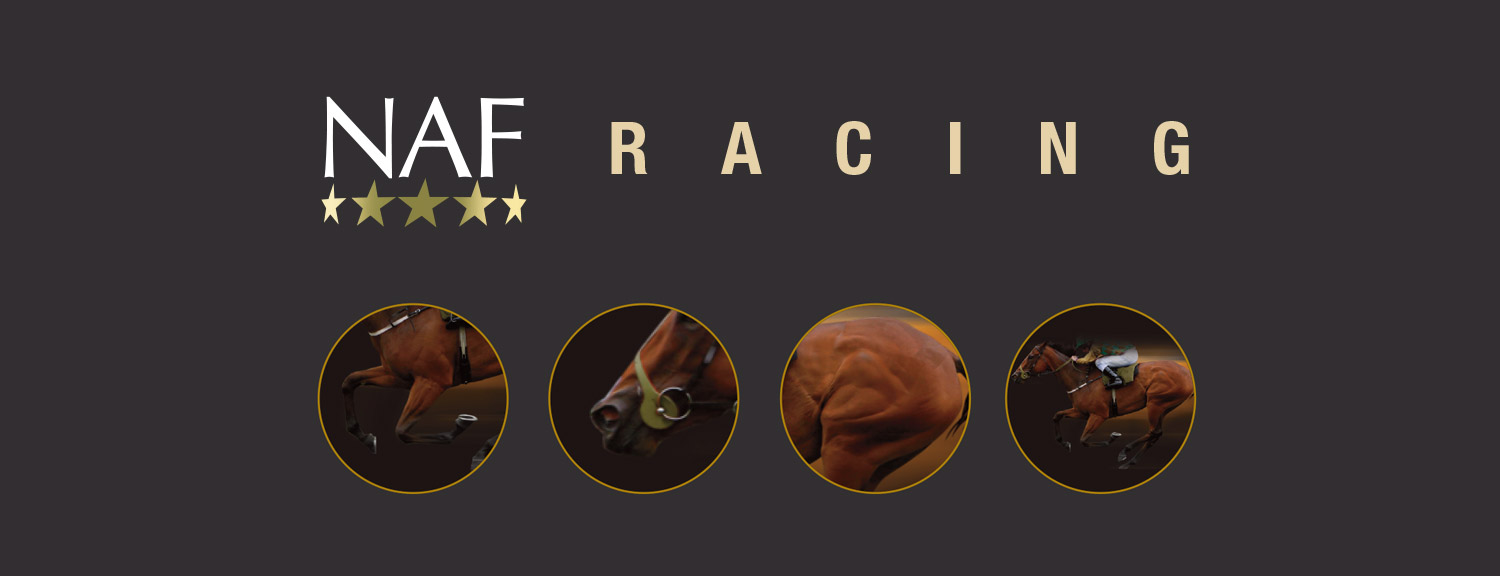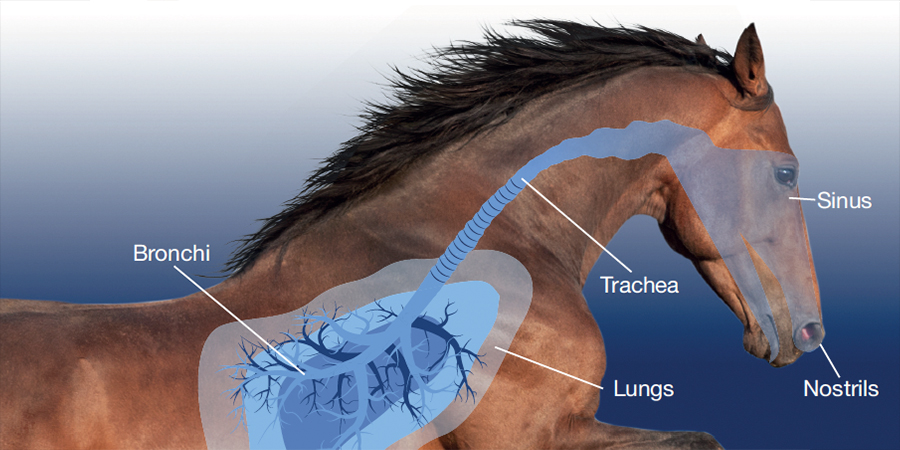



Recent research shows the threat to your racehorse’s performance from their lungs.
The horse is superbly adapted to be a natural athlete, and those of us involved in bloodstock and racing celebrate that through our sport. However just like the mythological warrior, Achilles, for every strong athlete there is a weak point. Researchers have suggested that for racehorses their Achilles Heel for performance, is the respiratory system. Given their high muscle mass with respect to size, and formidable physiological requirements of racing, the need to uptake sufficient oxygen and clear the carbon dioxide load, against the limits of their respiratory system, really sets the performance boundaries.
This can be seen with research that shows a linear progression between VO2max* in racehorses and speed at submaximal pace. This explains why exercise results in oxidative stress in the horse, and the harder the exercise the greater the stress. Once speed and effort exceed VO2max the racehorse must switch to anaerobic metabolism to produce energy. Anaerobic exercise is inefficient and short-lived as, by necessity, it results in oxygen debt and fatigue must set in.
For for trainers looking for that extra winning edge it’s important that every consideration is given to the racehorse’s nostrils, trachea and lungs to ensure they are fit and ready to run. Racehorses at canter and gallop breathe perfectly in time with each stride, a phenomenon known as respiratory-locomoter coupling, so to increase oxygen uptake we need to look at maximising every breath rather than increasing respiratory rate. However the good news is that VO2max can certainly be increased with training, and in order to take that opportunity you need to recognise the importance of respiratory challenge on your yard and tackle it head on.
So is respiratory challenge your biggest covert enemy? Horses have a very low cough response compared to humans, meaning observing horses to see if they cough is a really poor indicator of respiratory disease. It’s true those horses who do cough will almost certainly have a respiratory challenge, but so might those who don’t. Established research shows that over 80% of horses referred for clinical examination due to poor performance had sub-clinical respiratory disease. Research in healthy riding horses shows lung issues in over half, but current research shows that figure increases dramatically in racehorses.
*VO2max is the measurement of the maximum amount of oxygen that an individual can utilise during intense, or maximal exercise. It is measured as millilitres of oxygen used in one minute per kilogram of body weight (ml/kg/min). VO2max is one factor that may help determine an athlete's capacity to perform sustained exercise.
A recent study in Canada examined 95 racehorses following euthanasia. All had been in active training and racing, and none showed any clinical signs of respiratory disease. However at post mortem most of them were found to have sub-clinical IAD (Inflammatory Airway Disease). Various signs were measured, such as inflammatory score of the lungs, and results showed all signs were present in all horses, from levels of 80% up to 98%.
If we think about the typical triggers of respiratory disease in horses we can understand how racehorses are likely to be so highly susceptible.
Infectious triggers such as a virus; Allergic triggers from pollen, mould or spores; Irritants such as dust from stable bedding, sand tracks and regular travel, and other issues such as physical impairment will impact on the lung’s ability to work optimally. So even for those showing no outward signs, thinking about optimising respiratory function is not about maintaining health, it’s about maximising performance.
A review of management is advised to see whether simple improvements to regime can improve respiratory health in the whole yard. Ensure stables are well ventilated, feed from the floor to aid natural drainage, and allow horses to lower their heads during travel are all good advice. So too is to ensure the diet provides natural antioxidants to balance the oxidative load of performance. For specific respiratory health, provide daily antioxidants alongside essential herbal support, such as clove and eucalyptus, to maintain healthy airways. Clear lungs are paramount as we know mucilage accumulation within the respiratory tract may impair airway permeability, hence limiting gaseous exchange, and that all important relationship between VO2max and speed.
The resting breathing rate of a healthy racehorse is around 12 – 14 breaths / minute, and that can increase to 150 breaths per minute when galloping.
Resting tidal volume is around 5-6 litres, and increases to around 13-15L during exercise.
The intrapleural pressures of inspiration and expiration may be 15 times higher when galloping compared to at rest.
At peak exercise, racehorses may be moving over 2000 Litres of air through the lungs every minute – that’s around 130 typical water buckets full!
Unlike other mammals, in horses the respiratory system is considered the limiting factor to exercise potential, so ensuring your racehorses have clean wind to race on is an essential.
Selected References
Fe ter Woort DVM, DVSc; et al (2018) Histologic investigation of airway inflammation in postmortem lung samples from racehorses. American Journal of Veterinary Research: March 2018, Vol. 79, No. 3, Pages 342-347
Larkins NJ, Deaton CM & Jones K (2006) Efficacy of a plant based formulation in the treatment of Recurrent Airway Obstruction in Horses. Planta Medica. 54th Annual Congress on Medicinal Plant Research. 11(72) 977-978
Knight J & Larkins NJ (2003) Antioxidant status of horses BEVA Congress 2003, Birmingham

Understanding the anatomy
The respiratory system is highly capable in enabling the horse to maximise their aerobic capacity, this means the horse utilises oxygen to fuel their exercise activity. If this process of gaseous exchange is hindered in any form, it can have a huge impact on overall performance which highlights the importance of a healthy respiratory system. This can be increased vastly during exercise but the respiratory system does not change as the horse gets fitter. This means that the respiratory system can have vast performance limitations should it be hindered as it can impact the horse’s ability to train and become fit.
At rest:
During exercise:
Coping mechanism
When horses flare their nostrils they can increase the amount of air that enters the upper respiratory tract and therefore increase their aerobic capacity. Horses cannot breathe through their mouth which helps prevent them from inhaling food but it highlights the need to keep the sinuses clear.
The modern lifestyle
We can see respiratory stress in horses occurring all year round. Over winter it’s the dust and natural spores associated with winter forage and bedding, often in combination with an increased amount of time stabled, that brings the challenges. During the warmer months it is pollen that proves to be a nasty trigger. Don’t forget also regular travel, particularly over long distances, and the use of surfaces can bring its own dusty challenges.
The Cough
Signs of respiratory stress can vary from coughing to mucous, to the sub-clinical, which may only be seen as a horse performing below par.
All horses can cough; it is a very simple technique for the airway to keep itself clear from debris. This debris can be a speck of dust from the air to debris entering the airways when they eat and drink. However, coughing can be a prerequisite for an inflammatory condition.
Veterinary advice and attention is recommended if the coughing persists and if mucus is present. There are however, lots of different ways to offer them daily support.
Stabled horses
Bedding
Forage
Outdoor air
Travelling
Dietary Support
Research shows that targeted dietary support can help to maintain healthy, clear lungs in horses. Just as we might choose hot lemon for its Vitamin C if we’ve got a blocked nose, so natural antioxidants are also recommended for our horses. Look for natural antioxidants fed in combination with key herbs recognised for lung health, such as echinacea, eucalyptus and clove. Add your chosen supplement to feed daily, and don’t forget to feed both the bucket feed and forage from the floor, which aids natural drainage.
Better Together
Research shows that targeted dietary support can help to maintain healthy, clear lungs in horses. Just as we might choose hot lemon for its Vitamin C if we’ve got a blocked nose, so natural antioxidants are also recommended for our horses. Look for natural antioxidants fed in combination with key herbs recognised for lung health, such as echinacea, eucalyptus and clove. Add your chosen supplement to feed daily, and don’t forget to feed both the bucket feed and forage from the floor, which aids natural drainage.
NAF © 2024 | NAF is a trading name of Greencoat Limited, registered in England & Wales. Greencoat Ltd - Registered address: Weston Centre, 10 Grosvenor Street, London, W1K 4QY. Registered Number: 1560 108. Registered in England & Wales.Number: 1560108 VAT Registration Number: 378 9295 80